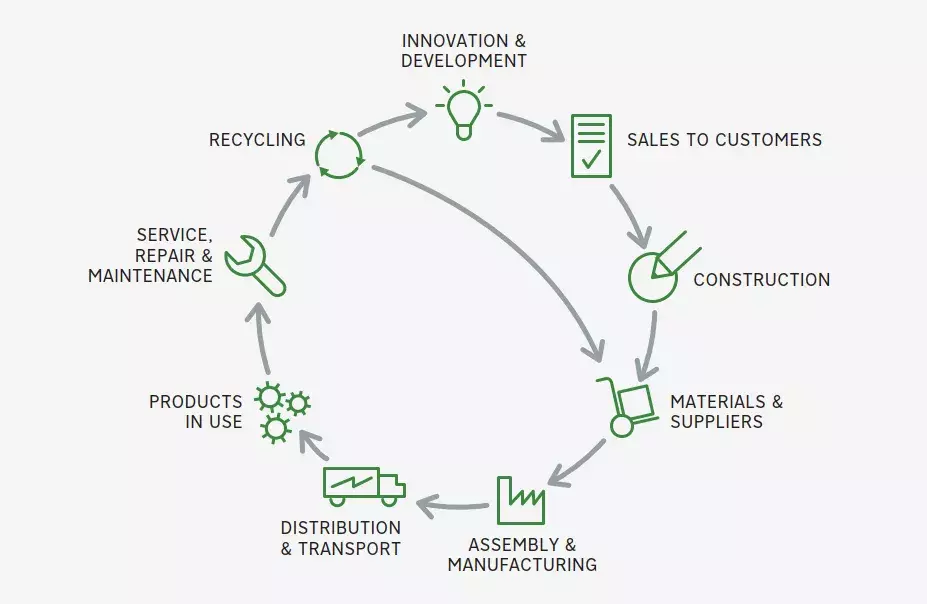
Our sustainability agenda: intensive, ambitious and collaborative
- Sustainability initiative
Over the last eighteen months, Bruks Siwertell has significantly deepened its sustainability agenda, developing a robust, measurable and accountable sustainability strategy, which is now road-mapped with goals and ambitions in place.
Since the company’s founding, Bruks Siwertell has always been proud of the environmental credentials built into its technology. But in today’s world, every business in industry must acknowledge how much work there is to do to address climate change.
“We work in environmentally intensive industries, so this is a challenge,” says Peter Jonsson, CEO, Bruks Siwertell Group. “But it is a challenge that Bruks Siwertell Group is taking on. Our main aim is to set the sustainability standard for the industries that we serve. This includes the dry bulk handling, wood-processing and forestry sectors.
“Our sustainability work is assessed from an environmental, social, and governance (ESG) perspective,” Jonsson continues. “It is also linked to the seventeen United Nation’s Sustainable Development Goals (SDGs), nine of which have been identified as areas of focus following a recent analysis.”
SDGs are designed to guide reflection and action on the most critical challenges, and opportunities facing humanity and the natural world. The toolbox for achieving them is the UN Global Compact principles. Bruks Siwertell’s sustainability work supports and integrates these into the Group’s policies and processes.
A busy, but rewarding year
Last year, we really started to formalize our sustainability journey, laying the foundation for this work. It has been wonderful to see our personnel’s interest and commitment to it,” Jonsson notes. “We have also recently released our first full sustainability report.”
In brief, over the last eighteen months, Bruks Siwertell Group has: appointed a sustainability team with representation from all business units; conducted a Group-wide materiality analysis, including risk analysis and stakeholder dialogues; developed a multi-year sustainability strategy at Group level and a sustainability policy; developed local action plans; and vastly increased the awareness of its sustainability work in general.
“This intensive program has been critical to understanding the baseline environmental impact of the business, and the company’s potential to improve across all areas of sustainability,” explains Anna Halling, Chief Strategy Officer, Bruks Siwertell Group.
“We have also developed a new line of communication and graphics: Handling The Future. ‘Handling’ is a key word within the company, with equipment transferring dry bulk materials and processed wood in ports, forests and industrial settings and facilities.
“We hope this new campaign represents our sustainability aims in a clear way. For us, Handling The Future means that we will do what we can, and what it takes now, to drive a more sustainable world, preserving it for future generations,” Halling adds.

Getting down to details
The Group-wide materiality analysis was essential in mapping Bruks Siwertell’s sustainability strategy and has resulted in challenging but clear focus areas, with set ambitions to be achieved by 2030.
Bruks Siwertell’s environmental focus areas are product development, as well as energy, waste and emissions reductions. Work is underway to review electricity consumption by installing energy-efficient lighting and appliances in all offices and advocating renewable energy sources where possible. These measures have resulted in a reduction in the Group’s electricity consumption. The Group has also continued the phasing out of heating oil, in favor of certified renewable electricity.
The Group’s carbon footprint is reported according to the guidelines in Greenhouse Gas (GHG) Protocol scopes 1 and 2, and despite the increase in business activities during 2022, total energy consumption, measured in MWh, has been reduced by eight percent since 2021.
“We are also working to reduce our greenhouse gas emissions throughout the value chain,” says Halling. “This year, each company within the Group will carry out climate calculations throughout their operations, and include direct and indirect emissions. This will enable us to prioritize actions in the areas where we can do the most good.”
Ambitious but achievable goals
Bruks Siwertell has set a target of reducing greenhouse gas emissions by 50 percent by 2030, compared to a base level established in 2019.
“In addition to this, we have set other ambitious and measurable environmental protection targets. By 2030 we are aiming to: switch to 100 percent renewable electricity; bring the amount of waste generated in our global business units to zero; and ensure 90 percent circularity in our entire product range. These will be achieved through product development, and reducing waste from our operational emissions and energy use,” Halling highlights.
“Seeking circular solutions are important to reduce the overall environmental impact of the business and are therefore priority issues for Bruks Siwertell,” Halling continues. “Our service teams carry out repairs and maintenance to extend the service life of equipment and contribute to a reduction in waste. Service teams also ensure that customers understand how equipment is best operated and maintained, with optimal settings that lead to energy savings.
“To support these efforts from offices upwards, we are looking for solutions where the waste contractor can be a partner, who in addition to the management of existing and relevant waste fractions, can also offer functions for measurement, follow-up and development.”

A priority: happy, healthy people
The company’s focus areas for the social element of its sustainability work comprise health and safety, personnel satisfaction and diversity and inclusion. “We recognize that happy, healthy people are fundamental to good business, and we are embracing this philosophy,” Halling stresses.
In 2022, Bruks Siwertell introduced a system for Group-wide employee satisfaction surveys. The results are recorded as an employee Net Promoter Score (eNPS), which is scaled from -100 to 100. The eNPS value is one of Bruks Siwertell’s new key figures. It has only been measured once before, delivering an eNPS score of 25, which demonstrates good levels of satisfaction, but by 2030, the aim is to raise this to a target score of 30.
As well as raising personnel satisfaction, by 2030 Bruks Siwertell is aiming for zero workplace accidents, and boosting gender equality by having at least 30 percent managers who identify as female.
A clear signal from the top
The third aspect of Bruks Siwertell’s sustainability work is governance and the sustainability focus areas within this are anti-corruption, supply chain management and management systems. These are essential to ensure that the company steers in the right direction. Bruks Siwertell’s main directives and goals have been evaluated and set by its owners, JCE Invest AB and Cargotec Sweden AB, and the senior management board.
“We recognize the urgency of the issues that we are working on. With our long-term ambition to set the sustainability standard for the industries that we serve, it is easier to drive towards this when owners and management have a common understanding of the importance of the issue,” Jonsson says. “Our measurable governance goals by 2030 have been set as 100 percent compliance with Codes of Conduct for both suppliers and customers and 100 percent of work processes updated and improved.”
Sustainable value chains
Bruks Siwertell already delivers ship unloaders, loaders and conveyors that possess the key elements for environmental protection: no spillage; minimal dust emissions; low noise levels; equipment reparability and longevity; low energy-consumption demands; and extremely high through-ship efficiencies, which maximize vessel turnarounds leading to the increased efficiency of dry bulk trades. Many of these elements extend to the Group’s wood-processing systems as well.
At each point of technological development, the environmental impact of equipment has been addressed, but this is not a static process. Sustainability encompasses much more than an environmental lens and extends throughout the value chain. Bruks Siwertell’s value chain comprises nine key areas: innovation and development; sales to customers; construction; materials and suppliers; assembly and manufacturing; distribution and transport, products in use; service, repair and maintenance; and recycling.
The chain starts with understanding customer needs and market knowledge, driving the company’s development projects. This is a continuous process, occurring during projects where customers require specific solutions that are adapted to their operational requirements.
The sale of equipment happens through representatives, partners, and dealers, with lead times dependent on the equipment and customer requirements. This is followed by the construction phase, and can comprise project-based, tailormade or standardized products.

Critical elements in the cycle
External collaborations with suppliers are critical and set within the Group’s Code of Conduct framework, enabling long-term, successful relationships. This includes materials suppliers as well. The majority of Bruks Siwertell’s products can be manufactured by completely or partly recycled materials, with assembly or manufacturing from these materials taking place as close to customers as possible, reducing the impact of transport.
Transport, both in the form of deliveries to the factory and the distribution of products and systems to the customer, is mainly carried out by truck freight. In specific circumstances, container vessels or break bulk vessels are used because of the size of the equipment, and when ship unloaders are delivered fully assembled, this is carried out via heavy-lift vessels.
Our products are used, for example, in port operations, forestry settings, sawmills, power plants and pulp and paper industries. These are challenging environments with high demands on efficiency, reliability and safety. A key part of a product’s ongoing performance is service, repair and maintenance. A commitment to through-life care underpins Bruks Siwertell’s delivery promises. Once equipment, which is predominantly steel, has reached the end of its service life, the majority can be recycled.
No stopping us now
“Over the past year, we have set our strategy and carried out extensive mapping and planning work. This year it is time to move from plan to action. Going forward, it is important that we continue to ensure that we have sufficient resources for this work and maintain the current commitment to continue to motivate our personnel. We will do this by communicating the impact that they are having.
“The intensity of Bruks Siwertell Group’s sustainability work will continue and is constantly developing as we learn more. If targets are achieved, we will set tougher ones,” concludes Jonsson.
PLEASE CONTACT US FOR MORE INFORMATION

Share:
More Blogs
Previous:
How can we help you? Bruks-Siwertell
Bruks-Siwertell